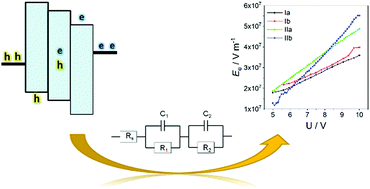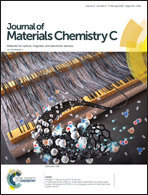Impedance spectroscopy of OLEDs as a tool for estimating mobility and the concentration of charge carriers in transport layers†
Abstract
The article presents a novel impedance spectroscopy based technique designed to characterise organic light emitting diodes (OLED) during operation. A number of devices based on NPB (N,N′-di(1-naphthyl)-N,N′-diphenyl-(1,1′-biphenyl)-4,4′-diamine) and TPBi (2,2′,2′′-(1,3,5-benzinetriyl)-tris(1-phenyl-1-H-benzimidazole)) conducting layers, CBP (4,4′-bis(N-carbazolyl)-1,1′-biphenyl) as a host and BPTZ-DBTO2 (3,6-bis(10H-phenothiazine-10-yl)-9H-fluorene-[dibenzothiophene-S,S-dioxide]) as an emitter were taken as an example to validate the method. Using equivalent electrical circuits, values of capacitance and conductivity of both hole- (HTL) and electron-transport (ETL) layers were determined and analysed separately. Those parameters, as well as current–voltage characteristics, were used to calculate (i) mobility (μ, cm2 V−1 s−1) of both types of charge carriers, (ii) charge density (n, cm−3) of the charge carriers, and (iii) electric field intensity (E, V m−1) in both transport layers as functions of the applied voltage.



 Please wait while we load your content...
Please wait while we load your content...